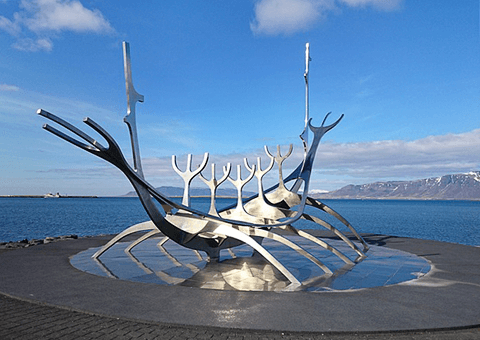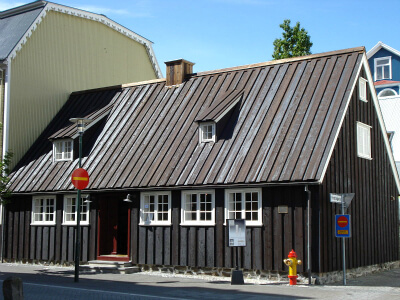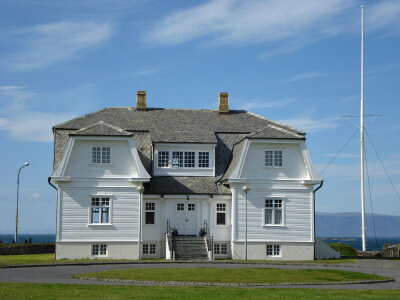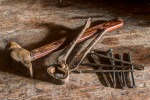Reykjavík city guide: Things to see
This compact Reykjavík city guide will lead you to the nicest places of the great small capital and its surroundings. Spend some days in the comfort of the city before venturing out in the wild outdoors, or upon return, as a well-deserved compensation!

In search of a perfect gift?
Consider Arctic Arc, a luxury photo book with 48 original panoramic photographs from Iceland and Greenland, seamlessly printed edge to edge over the fold!
You may want to rotate your phone in order to improve your browsing experience on this site.
Quick links
In Reykjavík
Reykjavík is full of architectural and cultural landmarks spread all over its territory. Choose a sunny day for a pleasant stroll through the town, stopping at museums, cafés and shops along the way.
For your stay in the capital, you might consider investing in the Reykjavík City Card. Apart from free entry to thermal pools and principal museums, unlimited use of city buses and the ferry to Viðey island, the card offers discounts on many attractions in the area including selected tours, shops and restaurants.
The card is available for the duration of 24, 48 or 72 hours at the Tourist Information as well as from several tour operators, accommodations and museums around town. In summer 2018 it cost 3,800 ISK for 1 day, 5,400 ISK for 2 days and 6,500 ISK for 3 days. There are also special cards for children from 6 to 17 years old, selling at a significant discount.
Reykjavík sightseeing tour
Start at the most prominent of all sights, the omnipresent Hallgrímskirkja. The impressive white church perched on a hill in the centre of the capital is framed by columns resembling volcanic basalt, a distinctive feature of the Icelandic landscape. The church's tall tower reminds of an erupting geyser, yet another iconic symbol of the country. There is an observation platform atop.
Just across from the church, the Einar Jónsson Museum was the first art museum in Iceland, and the first building erected on the Skolavörðuhæd hill, then at the outskirts of the town. The museum is open daily except Mondays from June to mid-September and on weekends during the rest of the year. It is closed in December and January. The sculpture garden behind the house is open all year, the access is free.
Continue along Freyugata in the direction of Tjörnin and the National Gallery of Iceland. The gallery is open daily except Mondays, the admission is free for holders of Reykjavík City Card. You can also purchase one here.
Cross Fríkirkjuvegur and take the footpath along the pond to the City Hall. The relief map of Iceland in the foyer is a true magnet for visitors. There are several exposition halls, an information desk, and a café overlooking Tjörnin.
From here it's a short walk to Aðalstræti with the Settlement Exhibition at no. 16, presenting the earliest excavation finds from city's past. A separate exposition is devoted to the Settlement Sagas. The museum and the exhibition are open daily and free with the City Card.
 Reykjavík's oldest house
Reykjavík's oldest houseThe house no. 10 is city's oldest wooden building. Further along the street, the Tourist Information Centre is at no. 2.
Turn left into Tryggvagata where two city museums are located side by side. Reykjavík Art Museum has 3 locations around the city which all can be visited with a single ticket on the same day, or for free with the City Card. The collection in the Hafnarhús at Tryggvagata no. 17 is centred around works of Erró, the best known contemporary artist of Iceland.
The neighbouring building, Grófarhús at no. 15, houses the city library and the Reykjavík Museum of Photography. The museum's collection comprises over 5 million images created by professional and amateur photographers between 1870 and 2002. The exposition in the 6th floor is open daily, the entry is free.
Follow Tryggvagata to its beginning and continue on Geirsgata to the Old Harbour and further on through its grounds to the Maritime Museum. Cross the vestibule and leave the building onto Grandagarður. Turn to the right for a walk through Grandi, the most dynamic district of the city with numerous cafés and shops on both sides of the street. Climb atop Þúfan, an artificial hillock by the artist Ólöf Nordal, and walk on a narrow causeway to the light at the entrance to the harbour.
Take bus no. 14 back to the city centre and get off at Lækjartorg. Opened in 2009, the Concert and Congress Hall Harpa by the waterfront has since been competing with Hallgrímskirkja for the title of the main city sight. The building houses 4 auditoriums, 2 restaurants, and offers daily guided tours allowing an intimate look behind the scenes, quite literally. City Card holders get 25% discount on the tour price.
The beautiful sculpture of a Viking ship aiming for the sea, Sólfarið, or the Sun Voyager, off Sæbraut is a fitting location to welcome the sunset whenever it might happen around the year.
 Höfði House in Reykjavík
Höfði House in ReykjavíkThe Höfði House, former residence of French ambassadors further along Sæbraut, or by bus no. 12, made headlines in 1986 as the location for the historical meeting between the world leaders Ronald Reagan and Mikhail Gorbachev. The event put an and to the Cold War, and opened the path to Europe as we know it now.
At last, walk up Nóatún or head to Hlemmur bus station and get on bus no. 18 to Perlan, the Pearl, another emblematic city landmark. The glass dome sitting on top of 6 tanks with geothermal water is surrounded by a terrace overlooking the city. The structure is home to a visitor centre, exhibitions and souvenir shops. The rotating restaurant on the upper level is a great spot for a romantic evening or a memorable celebration, offering unprecedented views of the city flowing under your eyes while you dine.
In the capital area
Towns surrounding the Icelandic capital also offer some sites – and sights – well worth exploring.
Garðabær
Garðabær, "the garden town", offers a spectacular setting between lava fields of the Heiðmörk Nature Reserve and the ocean.
The Hofstaðir Archaelogical Park presents remains of a farm from the Settlement age. The nearby Museum of Design and Applied Art is devoted to the Icelandic creativity and presents countless items dating as far back as the beginning of the 20th century. The souvenir shop on the premises is a good place to look for some original gifts to bring home.
Álftanes at the seaside is home to the official presidential residence Bessastaðir. The estate has been used for this purpose for centuries and is a true national landmark.
Garðabær's main bus station, Ásgarður, is served from Reykjavík by bus no. 1. Bus no. 23 continues to Álftanes at least once every hour on weekdays and Saturdays.
Mosfellsbær
The most famous of Icelandic authors, the Nobel Prize winner Halldór Laxness, had been living and working at the Gljúfrasteinn estate for half a century. Situated past Mosfellsbær off the road to Þingvellir, the house is open to visitors.
Getting there by bus from Reykjavík will require some planning ahead. Take bus no. 15 from BSÍ or Hlemmur to the Háholt bus station in Mosfellsbær. From there, bus no. 27 is scheduled to run to the estate several times a day – when ordered by phone at least an hour in advance of the intended departure. The fixed times correspond with the arrival of buses from Reykjavík.
Your best bet to get to Gljúfrasteinn during its opening hours is the service leaving Háholt past 12 pm (12:16 on weekdays, 12:20 on Saturdays, or 12:45 on Sundays). Stay on the bus all the way until the last stop. (This happens to be at the crossing with the road leading to the farm where the future writer spent his childhood.) From the bus stop it's a short walk to the museum further on along the road to Þingvellir.
Return buses – also subject to pre-order – leave for Mosfellsbær from the same spot at 4:23/4:27/4:52 pm on weekdays/Saturdays/Sundays. Call 588-5522 to arrange your rides.
Seltjarnarnes
The smallest of the communities in the capital area, Seltjarnarnes, lies to the west of Reykjavík on the tip of the latter's namesake peninsula.
Located in a nature reserve and encircled by walking and cycling paths, the town attracts locals and visitors alike for its unobstructed views towards the ocean and as far as Snæfellsnes. It's a great place to enjoy a sunset, Northern Lights, or a round of golf on its 9-hole course.
Grótta, an island connected with the town by a causeway, features an old lighthouse and rich bird life. Situated in sight of the lighthouse on the northern shore of the town by a shark curing shed, the smallest hot pool in Iceland is a welcoming spot for a warm foot bath. Kvika, as the place is known, is another creation of Ólöf Nordal.
Seltjarnarnes is served by bus no. 11 from Lækjartorg. NB: Grótta is closed to visitors during the nesting season in May and June.
Tags: #reykjavik #cityguide #sightseeing
Useful links
- Reykjavík City Card
- Consult the official site for benefits, prices, and places to buy.
- National Gallery of Iceland
- Pay a virtual visit to the most valuable collection of works by Icelandic artists.
- Reykjavík Art Museum
- Learn about current events and exhibitions in the leading contemporary art museum in Iceland.
- Reykjavík Museum of Photography
- See what's on, browse the online archive with 37,000 photographs, and order some of them as enlargement or a digital image.
- Harpa
- Stop by at the new heart of the Icelandic capital.
- Gljúfrasteinn
- Get to know the most famous Icelandic author in his home and workplace.
Other articles about Reykjavík
- Reykjavík 101
- Introduction to the great small city: seasons, events, and connections.
- Things to do
- There's always much to do in Reykjavík: make the best from your visit!
- Where to stay
- From a camping site to a 4-star hotel, there are many accommodation options for every budget. Find out which are the best.
- Where to eat
- Dining options in the capital of Iceland are plentiful, with the notable absence of fast-food chains. Good for you!
Other articles about Iceland
- Of ice and fire
- General information about Iceland.
- Beyond Reykjavík
- Read about sights and activities in different regions of Iceland.
Unattributed images on this page are sourced from Wikimedia Commons and Pixabay.
|
Tell me what you think!
Is it useful 👍? Awful 👎? Leave a message! Your comments help make this site better (and give me a kick—one way or another).
Popular articles
-
A kind of magic
If a digital picture has to be seen in the real world, printed on a real medium and displayed in a real showcase, its transition from RAW to real is better done in an old school image editor. Enter A…
-
A duck for a dog
If you got your own place on the Internet, helping your visitors find what they are looking for is a great way to engage them and keep them staying a bit longer. A custom site search can achieve just …
-
"Might as well have the best"
Aiming for better images? Think better lenses! This is your most important piece of gear, so you better get it sorted out. — Need some advice?
 Become a patron for
Become a patron for